Nanoleaf in June launched the Nanoleaf 4D Screen Mirror and LightStrip Kit, an LED gradient light strip designed to go behind a television set. It uses a camera to detect what’s on the screen, matching the color of the light strip to the TV’s content.
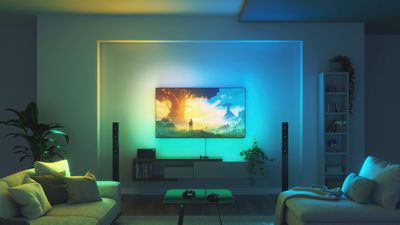
The light strip comes in two sizes, one that fits TVs and monitors up to 65 inches, and one that fits TVs up to 85 inches. Can be cut to the ideal size for a TV or computer monitor that is being used. I tested with an 85-inch TV, so I didn’t need to do any trimming, and size-wise, the light strip was able to wrap almost all the way around the TV.
There are 10 color zones per meter, so the light strip can display different colors at once, and like other LED light strips on the market, it supports more than 16 million colors. Nanoleaf specially designed light strips for TV sets and monitors and they are used for backlighting.
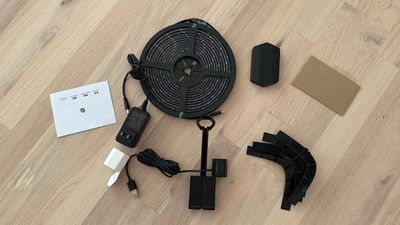

A camera is attached to the top of the TV with a mounting stand or it can be positioned below the screen and the colors detected by the camera are relayed to the light strip so that it matches what is displayed. Both the light strip and the camera are connected to a controller unit which itself plugs into a power outlet.
The way my TV is mounted, I have a small power strip on the back where I plug in the light I used glue to attach the controller, so all cords are hidden behind the TV. The lighting design facilitates a setup where all cords can be hidden, but you’ll need some strong adhesive. The controller unit has an option to turn on lighting effects, so you might want to keep it in a reachable location unless you’re always able to use the app for control purposes.
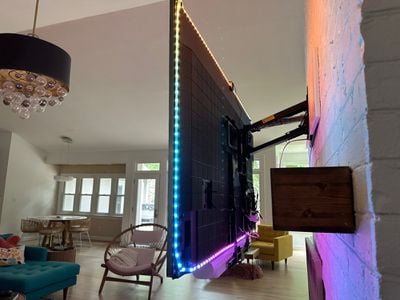

So far, the light strip’s adhesive is holding it to my TV, but there are a few corners where it’s coming loose. Nanoleaf includes some corner mounting hardware to route the 4D LightStrip into the corner, but the exterior design of my Sony TV didn’t work with the hardware. I had to use the light strip alone, and I didn’t have a good way to do the corners so they were always going to be angled in a weird way.
The main feature of the Nanoleaf 4D is the setup ability to mirror the colors on the display to the LED in the light strip so that the backlighting matches the TV content. There are HDMI boxes like the Hue Sync that do this, but with the Nanoleaf’s approach, you don’t need to plug everything into a central box and there are no limitations like no support for HDMI 2.1.
Backlighting that matches the content of a TV set or display adds immersion to what is being watched and is a fun addition to a home theater or gaming setup. Not having to route accessories like my console and Apple TV through a secondary box is a major plus for the method Nanoleaf is using to achieve this effect.
Having a camera on the top of the TV is a bit odd, but it quickly blends into the background and I don’t notice it now. The NanoLeaf includes a privacy cover for the camera when it’s not in use, but the camera doesn’t capture content and is only used to relay color to the light strip.
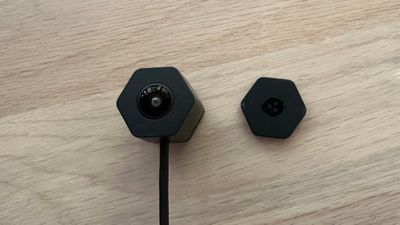

Nanoleaf has four “mirror modes” that affect the intensity of light and the frequency of color change. There are 1D, 2D, 3D and 4D. 1D is a simple lighting effect, 2D is a single color that matches a color on the screen, 3D is multiple colors and 4D is like 3D, but the colors change often. I prefer 2D or 3D mode over 4D, which can be a bit more confusing. My partner, who doesn’t care for the light behind the TV, had no problems with either 1D or 2D mode. I certainly appreciate the options Nanoleaf provides, as it ensures that the lightstrip can suit a wide range of tastes.
There are two modes for controlling color saturation. Cinematic is more subtle, while Vivid is more saturated. For movie content, I prefer Cinema, while games work well with Vivid, but there’s also the option to choose your own settings for saturation, dynamic range, and white balance. A rhythm mode can be activated to time the color of the sound coming from the TV, but the colors change so frequently that I wouldn’t recommend this mode if you’re actually watching TV. This is great if you have music playing in the background and want matching ambient lighting.
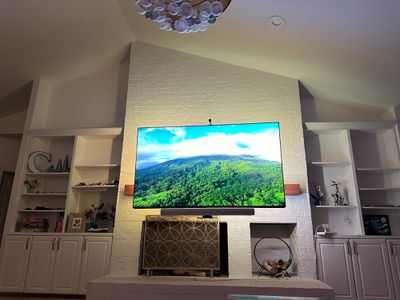

To match the color of the light to the appropriate portion of the TV content, a calibration process is performed via the Nanoleaf app. You mark each corner of the Nanoleaf lightstrip once it’s applied to the TV, and then you use the camera view to adjust what the camera can see. You need to make sure it only has a view of the TV and not anything around, as this will determine the colors you get.
The size (or perhaps position) of my TV seemed to be an issue for the camera and I wasn’t able to properly align each corner. I had to cut off a bit of the bottom corner, but I’m not sure how much that affects the displayed colors.
Color vibrancy will depend on the saturation of your TV, the lighting in the room, and what’s behind the TV. If your TV is a foot or two in front of a blank wall with a high-quality TV, you’ll see brighter, brighter colors depending on the content you’re playing. My TV is mounted above a brick fireplace with shelves on either side so I don’t have the most ideal setup for a light strip, but even in this situation, it casts a lot of light and casts color on most of the back of the TV.
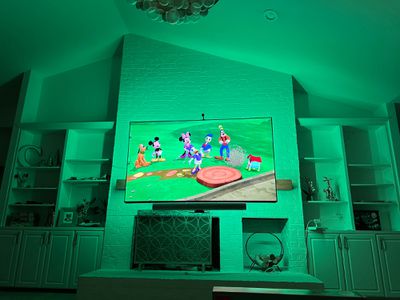

Colors in many TV shows and movies are more nuanced than you might imagine, so colors aren’t always super saturated and bright, even in 4D mode. For black shades, Nanoleaf seems to default to red, which doesn’t always match, and I seem to get a lot of green when there doesn’t seem to be much green on screen. Sometimes the camera chooses a dominant color, like white, instead of an accent color like blue or green, which looks better with the scene, so the algorithm that NanoLeaf is using may need some work.
I thought there might be some lag between what the camera picks up and the colors relayed to the screen, but the 4D setup seems quick to change colors. Colors match and blend with the background for the most part rather than being distracting, and this is especially true of the more subdued modes.
I think the camera system works well overall, and as someone who likes TV backlighting I enjoyed the color effects of the lightstrip, but where something like Hue Sync might have an edge is in color interpretation. The sync box is pulling color from the video signal instead of using the camera and I feel it gives me a more vibrant overall look, but it’s hard to compare because they are two different lighting systems.
As with the Philips Hue setup, you can add other Nanoleaf lights to the Nanoleaf 4D kit. If you have Nanoleaf light panels, bulbs, or light strips around your TV area or in your gaming setup, they will also automatically sync with the colors captured by the 4D camera. There is a calibration process where you can choose where each light is in the room for the best color sync.
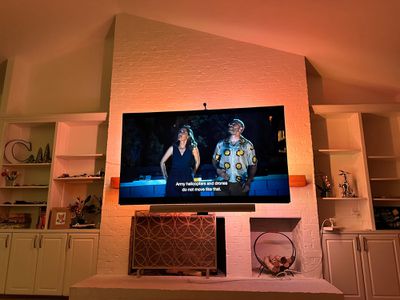

Being able to sync light panels and bulbs on the Nanoleaf 4D is great for gaming, but I think it can be a bit overwhelming when watching TV if the panels are on the same wall. I don’t have a light panel in the living room where I tested the 4D, but I did pull something out to test the syncing, and it definitely adds another layer of depth to the system. Nanoleaf currently has many lighting options including lines, light panels, bulbs and light strips that you can use to create an incredible entertainment area. Later this year, skylight ceiling panels are coming for even more flexibility.
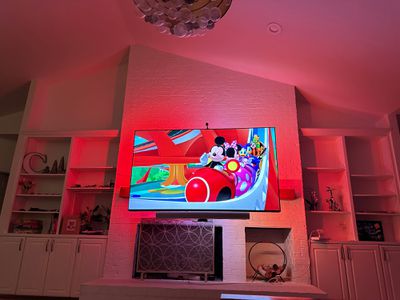

The Nanoleaf 4D setup is controlled via the Nanoleaf app, where you can set mirror mode, choose a color changing scene that has nothing to do with the TV’s content, or set a solid backlighting color. As with all Nanoleaf products, you can also create your own light scenes.
You can control the Nanoleaf 4D with the Home app, but it can only be turned on or off or set to a fixed color, so it’s an accessory where you have to have the Nanoleaf app.
Nanoleaf 4D bottom line
At $100, the Nanoleaf 4D Screen Mirror and Lightstrip Kit is a solid deal for what you’re getting. It’s an all-in-one hassle-free lightstrip that goes to the TV and a matching camera for color sync, so you can have a complete entertainment setup for $100 and 10 minutes.
Comparatively, the 4D Kit is much more affordable than something like the Hue Sync Box, which costs $250, making it an easier entry into the lighting ecosystem. I wouldn’t recommend it if you have a full setup of Hue lights in your living room because it’s only designed to work with Nanoleaf lights, but if you’re starting from scratch or already have a Nanoleaf panel, it’s a must-buy.
Nanoleaf’s Ultra Black Hexagon
Alongside the Nanoleaf 4D, Nanoleaf Shapes has also introduced the Ultra Black Hexagon, which joins the Ultra Black Triangle we reviewed last year. The Ultra Black hexagons are identical to the standard hexagons, but are made from a black plastic material that better matches dark color decorating schemes when not activated.
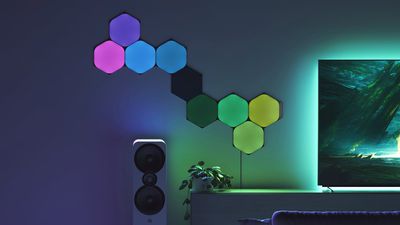

Hexagons are probably my favorite panel shape, and black looks better than white. With darker plastic, the edges connecting the hexagons blend better into the background and have an overall smoother look. Black hexagons look better on the wall when the lights are off, and when turned on, the color brightness remains the same. If you’ve ever wanted a Nanoleaf panel but put off the white plastic look when the lights aren’t on, the black panel is a great option.
Like all of Nanoleaf’s light panels, the hexagons can be set to any color, paired with triangles, and synced to a TV or display. Thousands of patterns and colors are available through Nanoleaf’s app, or you can create your own. The main downside to Nanoleaf’s Ultra Black Hexagons is the price – they’re $220 for a set of nine, like other Nanoleaf products.
When it comes to light volume, you can use them in place of a standard lamp, and the color options are second to none for those who prefer accent lighting. I don’t think people interested in light panels will be disappointed, even at the price. Nanoleaf has bundles and sales that can make them a bit more affordable, so it might be worth waiting for a discount.
How to buy
The Nanoleaf 4D and Lightstrip Kit for up to a 65-inch television set costs $100, while the Nanoleaf Lightstrip Kit for up to an 85-inch TV costs $120. There’s also a camera-only kit for $80, which can be used with an existing light strip.
Nanoleaf Shapes Ultra Black Hexagons can be purchased from the Nanoleaf website for $220 for a set of nine panels.
